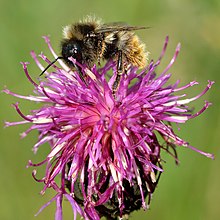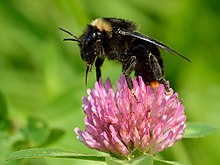| Bombus rupestris | |
|---|---|

| |
| Male | |

| |
| Female | |
| Scientific classification | |
| Domain: | Eukaryota |
| Kingdom: | Animalia |
| Phylum: | Arthropoda |
| Class: | Insecta |
| Order: | Hymenoptera |
| Family: | Apidae |
| Genus: | Bombus |
| Subgenus: | Psithyrus |
| Species: | B. rupestris |
| Binomial name | |
| Bombus rupestris (Fabricius, 1793) | |
| Synonyms | |
| |
Bombus rupestris is a species of cuckoo bumblebee present in most of Europe except Iceland. In the Balkans it is found in montane and alpine habitats northwards from Central Greece. It is also found in Turkey.
Description
The female is much larger than the male; she has a length of 20–25 mm (0.79–0.98 in), while the drone usually is not more than 16 mm (0.63 in). The bumblebee is black, with the last abdominal segments coloured orange-red.
Due to its parasitic lifestyle, no workers exist.
Behaviour
Bombus rupestris is found in flower-rich habitats, such as meadows and along hedgerows. The bumblebee parasitizes the nests of the red-tailed bumblebee, B. lapidarius, whose queen is killed or subjugated.
References
- "Bombus rupestris (Fabricius, 1793)". Biolib.cz. Retrieved 4 July 2012.
- Anagnostopoulos, Ioannis Th. (2009). "New records of bumble bees from the Northwestern mountainous region of Greece (Hymenoptera, Apidae)" (PDF). Entomofauna. 30: 445–449.
- ^ Discover Life. "Discover Life map of Bombus rupestris". Retrieved 28 February 2020.
- ^ Jim Lindsey (retired professor of Biostatistics). "Bombus rupestris". Archived from the original on March 13, 2008. Retrieved 28 February 2009.
- ^ Dr Brian Nelson, Ulster Museum. "Bombus (Psithyrus) rupestris – a cuckoo bumblebee". National Museums Northern Ireland. Retrieved 28 February 2009.
This bumblebee-related article is a stub. You can help Misplaced Pages by expanding it. |